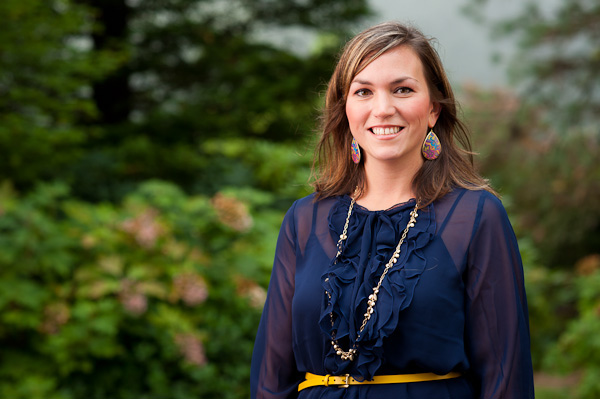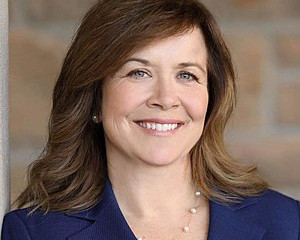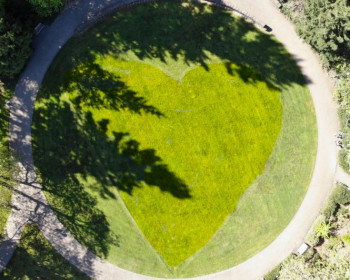Q&A with Sustainability Manager Amy Dvorak
Open gallery

Salmon Safe Certification and an increase in water-filling stations across campus are just two of Lewis & Clark’s current sustainability efforts.
The following Q&A with Sustainability Manager Amy Dvorak highlights some of the green practices at Lewis & Clark and offers opportunities for our community members to learn and do more.
What are the top priorities for sustainability efforts at Lewis & Clark in 2013?
There are a few things we’ll be working on this spring that people should know about:
- We’ll be highlighting our salmon-related education, research, and practice. We will be holding several events, including a book talk by Steven Hawley ’97 (author of Recovering a Lost River: Removing Dams, Rewilding Salmon, Revitalizing Communities), a faculty mixer, and a Salmon Safe Certification celebration event. We will be collating this information on an educational website.
- The Oregon Higher Education Sustainability Conference will feature private institutions for the first time this year, including L&C. We are a cosponsor and will have several attendees—including student speakers!
- The Green Fee Fund has spurred some interesting projects that we will continue to investigate and implement in the coming term. Keep an eye out for new stories highlighting approved projects!
What does the Sustainability Council do to recognize and engage in the best new sustainability-related opportunities?
A portion of each LCSC meeting is devoted to hearing from the community. The most promising projects and/or initiatives are then delegated to sub-committees for further research and implementation. We encourage the community to send ideas, questions, and thoughts to the group.
You were very involved with the process surrounding our STARS (The Sustainability Tracking, Assessment & Rating System) submission. How does STARS help define sustainability at Lewis & Clark?
The STARS rating program provides an opportunity to assess our progress over time, see how we rate relative to other institutions, and learn from recent best practices. Another key component of STARS is that it is connected to other rating systems such as the Sierra Club Cool Schools report card and the Princeton Review. While these systems do not offer a perfect definition of sustainability at L&C, they do provide a baseline for more rigorous discussion and implementation.
How much progress has been made toward Lewis & Clark becoming a campus free of bottled water?
Much has been accomplished on this issue over the years, including increasing the number of water-filling stations (more to come this year!), switching out five-gallon water containers for water filtration stations, and increasing the number of reusable containers provided to students and employees. This term the LCSC will consider a resolution to increase these efforts across campus, including working with Bon Appétit to reduce bottled water sales in vending and catering.
How can Lewis & Clark community members support sustainability efforts here on campus on a daily basis?
I think one of the most important efforts Lewis & Clark employees and students can do to promote sustainability is to support each other. As we build a strong community, we are more fulfilled individually and more successful as a group/institution. This is the primary reason I was thrilled to be involved in the CARE committee. All the little efforts (conserving energy, thoughtful purchasing) become easier with group support and shared goals.
If community members are interested in getting additional departmental information or resources, they are invited to fill out a student-created survey regarding current practices.
What is the one thing you would like people to know that you do in your personal life to further sustainability?
One life decision that brings me great joy is the neighborhood my family resides in. While it is not close to L&C (as my husband works in Salem), it is truly remarkable! The homes are of a smaller scale, Earth Advantage certified, front-porch style, and utilize shared green space instead of large, private back yards. We have numerous parks including a great Metro Natural Area, a community center, farmers market, and exceptionally active and engaged neighbors. It is a great place to promote community and active, aware lifestyles for my children.
What would you suggest to those of us who are interested in finding out more about sustainability at Lewis & Clark?
Please join us for an LCSC event, subscribe to our Facebook or LinkedIn group (we are getting great traffic from alumni!), or contact me directly. I would love to hear your thoughts!
Also, as a special event, we will host a Staples lead chemist, Roger McFadden, in March for a talk on the history and current practices in green chemistry and specifically those at Staples (where most departments purchases their departmental goods).
email source@lclark.edu

